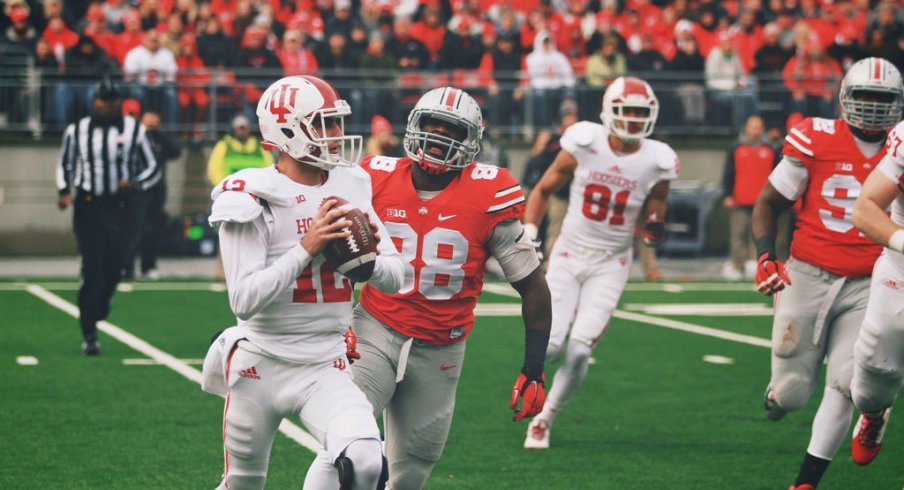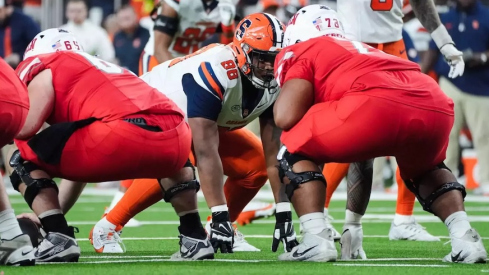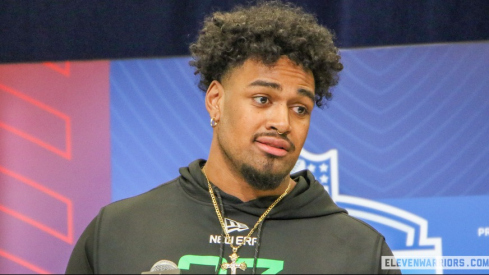Ohio State rolls into Bloomington this Saturday facing a 4-0 IU squad looking to force its way into the conversation of the top teams in the Big Ten.
Indiana quarterback Nate Sudfeld (285 passing yards p/game, seven TDs), running back Jordan Howard (168 rushing yards p/game; four TDs), and wide receiver Ricky Jones (102 receiving yards p/game; four TDs) lead an explosive IU offense ranked 14th nationally in total yards per game. Although questions remain about IU’s strength of schedule (Wins over Southern Illinois, Florida International, Western Kentucky, and Wake Forest), the Hoosiers feel they have the firepower to compete with an OSU offense that continues to suffer from lack of consistency and execution.
Indiana runs a spread-based offense that takes snaps almost exclusively from the shotgun or pistol with the goal of getting the ball to their athletes in space. They operate a “check with me” play-calling system in which in lieu of huddling, meaning the team immediately lines up on the LOS and looks to the sideline for the play call after the offensive coaches have scanned the defensive alignment.
The Hoosiers run a majority of their snaps out of “11” personal (1 RB and 1 TE). Much like Ohio State, the Indiana offense will use the TE in both a “traditional” three-point stance on the LOS (line of scrimmage), as well as in the backfield as an H-Back. IU’s tight ends will utilize a variety of blocks off their base inside zone runs, including “arc” and “wham” blocks.
The Hoosier offense looks to stress a defense’s interior and perimeter through the use of their base Inside Zone, Buck Sweep, RPO’s/Bubble screens, and a variety of play-action concepts that attack the short, intermediate, and vertical areas of the field.
The Bread and Butter
While the Indiana run game features several concepts including Outside Zone,the Buck Sweep, and Power, the offense builds its scheme of their bread-and-butter Inside Zone.

Buckeye fans are very familiar with Inside Zone as the play has been a bulwark of Urban Meyer’s offense over the previous two seasons. Rather than blocking a specific gap like the famous “Dave” or Counter, linemen follow “covered/uncovered” rules that has previously broken down here before. The RB will generally read the frontside (the direction in which the play will be run) or backside (the direction opposite of which the play will be run) interior defensive lineman to determine what hole to press.
In order to run inside zone effectively the C/G combination must get secure and get movement on the NT, with one of the two climbing to the 2nd level LB. Many teams coach this double team combination using the “4 hands 4 eyes” rule. When securing the block, both the C and G must get hands on the NT while maintaining eyes on the LB to read his flow to the ball. The LB’s path will determine who climbs to the 2nd level to block him.

The Hoosier O-line does a great job of creating lateral movement across the LOS creating several running lanes for Jordan Howard. Watch the left guard, Wes Martin (#76) wash the backside 2-technique (aligned heads up over the guard) down the LOS, giving Howard an easy read to press the backside A-gap.
While not the running threat of a Braxton Miller or even a JT Barrett, QB Nate Sudfeld has enough speed to pull the ball and run the QB boot when the “read” man crashes inside to play the running back on Inside Zone.

Sudfeld is reading the EMLOS (End Man on Line Of Scrimmage) through the mesh with the RB to make a "keep" or "give" read. If the EMLOS (the right OLB here) squeezes inside to play the RB dive, the QB will pull the ball at the mesh point and boot around the area the OLB has vacated.
If the EMLOS slow-plays the QB boot, Sudfeld will give to Howard running Inside Zone, as the offense has "read off" a defender who cannot now flow to the POA (point of attack).
Stressing the Edges
While the Inside Zone remain Indiana’s bread and butter, through the 1st four games of the 2015 season the offense has increasingly used the Buck Sweep, a gap-blocked play that features two pulling guards and a counter jab step by the TB. The offense has used this play to attack the perimeter with great success thus far; expect to see a heavy dose of the concept on Saturday.

The Buck Sweep blocking scheme will vary based on the defensive front, but in this example the play-side TE and RT will “down” block (block back towards the center), the center will “reach” block the NT, the backside LT will “wall off” the 4-technique, and the TE will climb to the backside LB.
While all blocks must be executed for the Buck Sweep to hit for a chunk of yards, the key blocks come from the pulling guards. The play-side guard will look to “kick out” the first defender that shows outside the TE's down block, while the back-side pulling guard will “wrap” through the hole and block the first defender that threatens to cross his face.
When executed properly, the Buck Sweep is a tough stop as the pulling guards allow the offense to outnumber the defense at the POA.

Focus on the pulling guards. Left Guard Wes Martin (#70) does an outstanding job of kicking out the scrapping LB, or “winning the D-gap.” Right Guard Dan Feeney (#67) leads through the hole to secure the first defender who threatens to cross his face (#41). RB Jordan Howard does the rest by pressing the D-gap with authority to eliminate the threat of any back-side pursuit to the ball.
The IU offense will also stress the defensive perimeter using the quick passing game. Offensive coordinator Kevin Jones uses his “check with me” offense to spot and take advantage of defensive misalignments over his receivers after the defense has tipped their alignment. Jones’ go-to play when he spots perimeter stress points is the “X” bubble screen.
After the Indiana offense has shown their formation at the LOS, the offensive coaching staff will scan the defensive alignment looking for scheme weaknesses to attack. One item they will always look for is the overhang defender’s leverage over the #2 WR. If the overhang is “inside shaded” over the WR, they will run a bubble to the slot as the defender is out-leveraged to the outside.

The SAM's inside leverage over the #2 WR prevents him from making a play on the ball carrier. By the time he recognizes the concept, the ball is already out and the slot is preparing to press upfield for a TD.
Constraining a Defense
Attacking LB’s and overhang players with RPO’s (Run/Pass Option) is a big part of IU’s offensive scheme.

The QB will “read” the Middle LB to determine run/pass. If the MLB widens into the slant window, he'll give on the Inside Zone as the offense will have a hat-on-a-hat blocking setup. If the MLB aggressively fills his run fit opening up a large throwing window, throw the slant into man coverage.

Pay attention to Sudfeld’s eyes as he meshes with the RB. You can clearly see the MIKE take a read step towards the LOS, vacating the throwing window for the slant route. If OC Kevin Jones sees opposing defenses keying and overplaying his bubble screen, he will dial up a PA concept off the screen action to take advantage of the secondary's aggressiveness and test defender's eye discipline.
After completing several bubble screens against Western Kentucky, the IU offense dialed up a clever PA concept that utilized a "dummy" screen from the #3 WR and switch routes from the #2 and #1 WR. The concept's goal is to catch the secondary "peeking" into the backfield at the dummy route, allowing the switch routes to get behind them overtop.

A Hoosier play that continuously shows up on their game film is a half-field OVS (Outside Vertical Stretch) concept off PA.
An OVS is a simple 3-level stretch that uses a vertical, intermediate, and shallow route to "stretch" the defense vertically (also known as a "hi-lo). Urban's go-to play, "Sail", is a common OVS popularized by the 'Air Raid' offense.

Indiana runs a "Swap" boot here off of Inside Zone PA. TE Michael Cooper initially releases using "wham" block motion to sell the PA, and then slips into the flat. The #2 WR runs a 10-yard out while the #1 WR runs a deep comeback.
Against a man defense the PA fake should hold the defender responsible for Cooper in coverage. Against a zone defense like Cover 3 the flat route and out route will work together to "hi-lo" the curl/flat defender, making him wrong no matter which route he jumps.
Due to the success of the running game, the Hoosier offense has successfully hit vertical PA passes downfield several times this season. Against Southern Illinois, Nate Sudfeld connected with Ricky Jones on a 57-yard TD via an outstanding PA concept.

The play starts up front with the PA fake and backfield flow by the RB and TE. Notice how the PA fake and backfield flow causes the Safety to take a hard step towards the LOS. Due to his pre-snap depth and post-snap read he is in no position to play overtop of the backside post route (in his defense this *may* have been Cover 0; he would then be responsible for a TE/RB).
The route concept is fairly simple, but very effective. The #1 and #2 WR both run in-breaking routes designed to catch the eyes of the deep Safety if he does not bite on the run fake, allowing the post to hit over his head. Because the FS is 8 yards off the LOS and has taken an aggressive run step, the post becomes a 1v1 route that a receiver of Ricky Jones' caliber will usually win.
Eye Discipline
What does this mean for the OSU defense? The OSU defense will play their base Cover 4 pattern-matching coverage shell.
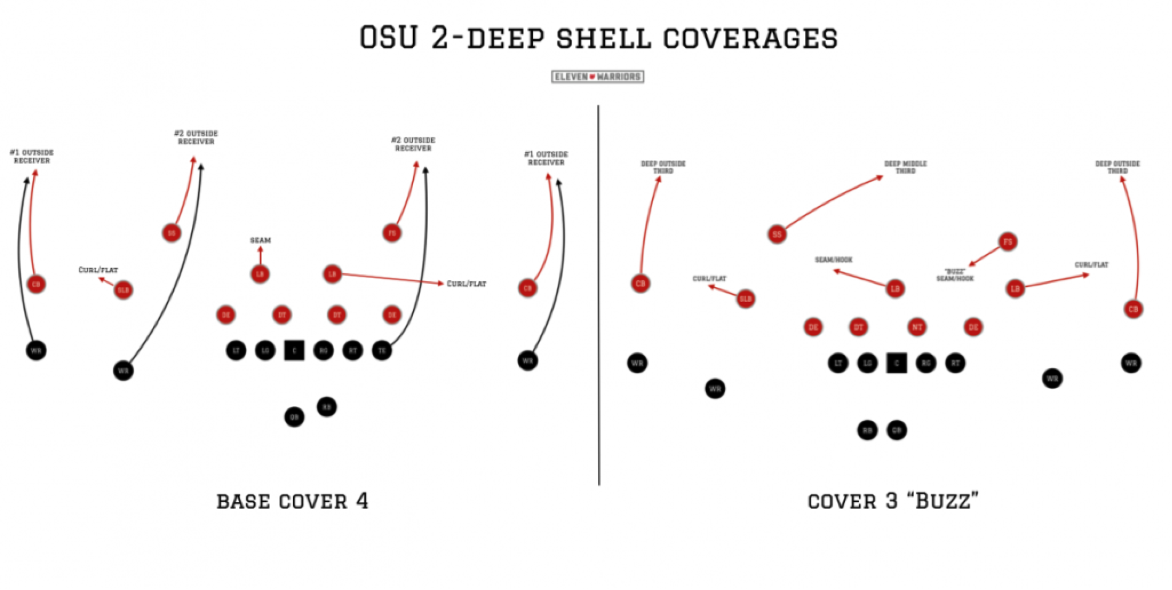
The OSU run defense must play gap-based, assignment-sound football to slow down Jordan Howard. The secondary and linebackerss must tackle in space to prevent chunk gains, particularly when IU attacks the edges with their outside run and screen game.
In order to keep IU's talented group of WRs from beating them overtop, Vonn Bell, Tyvis Powell and company must practice good eye discipline by reading their run/pass keys.
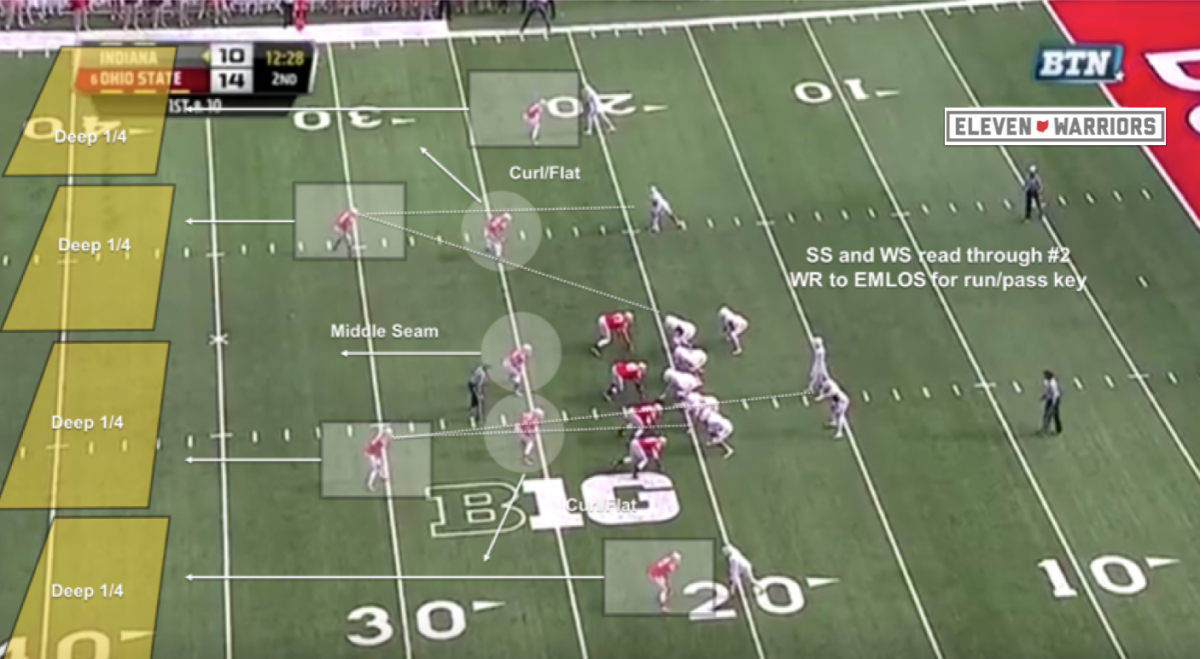
Cover 4 safeties will look through the #2 WR to the EMLOS for their initial run/pass key. A simple but effective rule for reading run/pass is the "hi-hat/lo-hat" rule. If the EMLOS player's head pops up, the defender will read pass as the offensive player is likely kick-stepping into pass protection. If the that player's head drops down, the defender will read run as the offensive player is likely sinking the hips to generate leverage as he run blocks.
The secondary must read keys without letting the eyes slip into the backfield where backfield motion will slow and confuse reads. So far the Buckeye secondary has done a great job of preventing teams from going overtop, giving up only 131.5 passing yards per game, good for eighth in the nation.
So far the Buckeye secondary has avoided giving up these long plays overtop. With IU's talented group of skill position players, will this be the week they're truly challenged?
Editor's note: This is the first 11W article by Jonathan Stephanson, who will be contributing to future Film Study pieces along with Kyle for the rest of the season. Let's give him a warm welcome in the comments, shall we?
